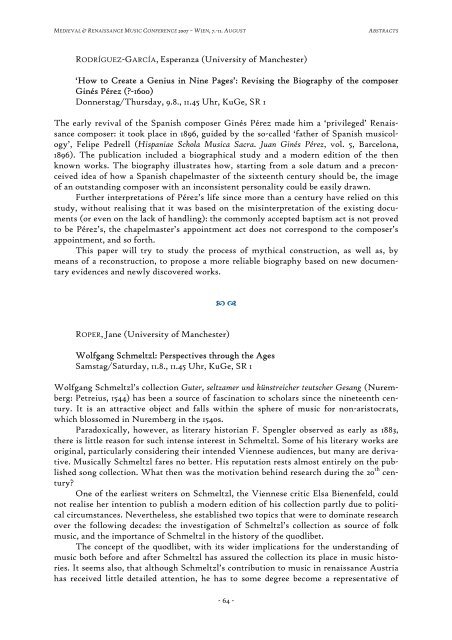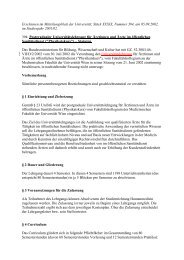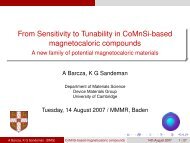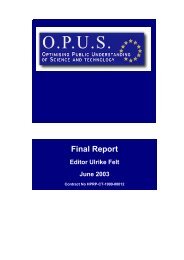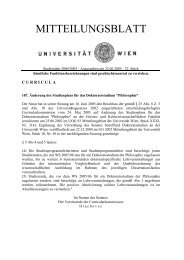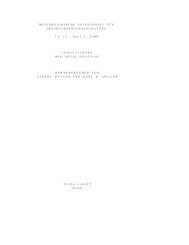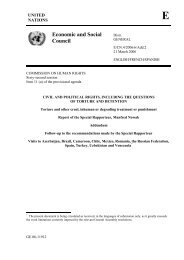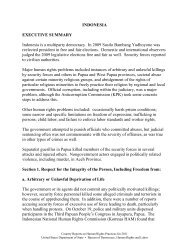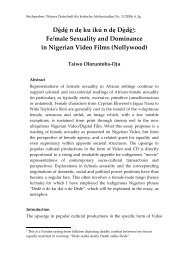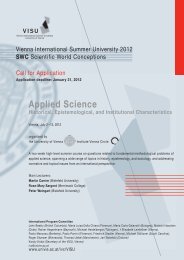(Stand: 25. Juli 2007) ANDERSON, Michael Alan ... - Universität Wien
(Stand: 25. Juli 2007) ANDERSON, Michael Alan ... - Universität Wien
(Stand: 25. Juli 2007) ANDERSON, Michael Alan ... - Universität Wien
You also want an ePaper? Increase the reach of your titles
YUMPU automatically turns print PDFs into web optimized ePapers that Google loves.
MEDIEVAL & RENAISSANCE MUSIC CONFERENCE <strong>2007</strong> – WIEN, 7.-11. AUGUST ABSTRACTS<br />
RODRÍGUEZ-GARCÍA, Esperanza (University of Manchester)<br />
‘How to Create a Genius in Nine Pages’: Revising the Biography of the composer<br />
Ginés Pérez (?-1600)<br />
Donnerstag/Thursday, 9.8., 11.45 Uhr, KuGe, SR 1<br />
The early revival of the Spanish composer Ginés Pérez made him a ‘privileged’ Renaissance<br />
composer: it took place in 1896, guided by the so-called ‘father of Spanish musicology’,<br />
Felipe Pedrell (Hispaniae Schola Musica Sacra. Juan Ginés Pérez, vol. 5, Barcelona,<br />
1896). The publication included a biographical study and a modern edition of the then<br />
known works. The biography illustrates how, starting from a sole datum and a preconceived<br />
idea of how a Spanish chapelmaster of the sixteenth century should be, the image<br />
of an outstanding composer with an inconsistent personality could be easily drawn.<br />
Further interpretations of Pérez’s life since more than a century have relied on this<br />
study, without realising that it was based on the misinterpretation of the existing documents<br />
(or even on the lack of handling): the commonly accepted baptism act is not proved<br />
to be Pérez’s, the chapelmaster’s appointment act does not correspond to the composer’s<br />
appointment, and so forth.<br />
This paper will try to study the process of mythical construction, as well as, by<br />
means of a reconstruction, to propose a more reliable biography based on new documentary<br />
evidences and newly discovered works.<br />
� �<br />
ROPER, Jane (University of Manchester)<br />
Wolfgang Schmeltzl: Perspectives through the Ages<br />
Samstag/Saturday, 11.8., 11.45 Uhr, KuGe, SR 1<br />
Wolfgang Schmeltzl’s collection Guter, seltzamer und künstreicher teutscher Gesang (Nuremberg:<br />
Petreius, 1544) has been a source of fascination to scholars since the nineteenth century.<br />
It is an attractive object and falls within the sphere of music for non-aristocrats,<br />
which blossomed in Nuremberg in the 1540s.<br />
Paradoxically, however, as literary historian F. Spengler observed as early as 1883,<br />
there is little reason for such intense interest in Schmeltzl. Some of his literary works are<br />
original, particularly considering their intended Viennese audiences, but many are derivative.<br />
Musically Schmeltzl fares no better. His reputation rests almost entirely on the published<br />
song collection. What then was the motivation behind research during the 20 th century?<br />
One of the earliest writers on Schmeltzl, the Viennese critic Elsa Bienenfeld, could<br />
not realise her intention to publish a modern edition of his collection partly due to political<br />
circumstances. Nevertheless, she established two topics that were to dominate research<br />
over the following decades: the investigation of Schmeltzl’s collection as source of folk<br />
music, and the importance of Schmeltzl in the history of the quodlibet.<br />
The concept of the quodlibet, with its wider implications for the understanding of<br />
music both before and after Schmeltzl has assured the collection its place in music histories.<br />
It seems also, that although Schmeltzl’s contribution to music in renaissance Austria<br />
has received little detailed attention, he has to some degree become a representative of<br />
- 64 -


